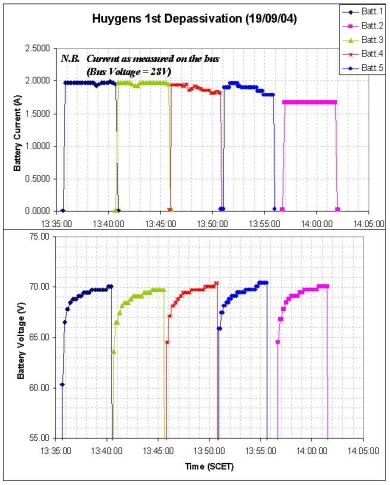No. 12 - First Battery Depassivation
Since the launch of Cassini-Huygens in October 1997, the Probe's five Lithium batteries have been maintained in a dormant state, with power for regular Huygens in-flight health checkouts being provided by Cassini. However, on Sunday afternoon they were woken up and, for the first time in more than seven years, provided power to the Probe in order to demonstrate their readiness for the mission in December 2004/January 2005.
Sunday's activity was important for a number of reasons, not least of which was that it prepared the batteries for use by removing a so-called "passivation" layer that forms within the cells, on the surface of their electrodes, when no current flows. This layer, which builds up naturally over time, enables the cells to retain their charge during the long Cassini cruise phase but may be problematic for operations during the Probe mission, hence the need to remove it in an activity called "depassivation".
In principle, depassivation is a very straightforward activity that involves connecting each battery to the Probe's power bus for a few minutes. However, what seems like a simple act of closing and then opening a set of relays was actually the culmination of a significant amount of planning and preparation - an effort that was made all the more important because each battery holds around 450 Wh of energy and therefore represents a significant hazard to both the Probe and the Cassini Orbiter.
 |
|
Depassivation sequence of the five batteries |
Five command sequences - one for nominal operation and four others for possible contingency cases - were prepared by the Huygens flight control team and pre-tested on the Huygens Engineering Model at the European Space Operations Centre (ESOC) in Darmstadt, Germany. One of these tests used a battery that was manufactured in the same batch as those now flying on the Probe, so there was a very high level of confidence in the operation design. The nominal sequence was selected for the flight operation, after analysis of data from the Huygens checkout F15 that was performed five days earlier, on 14 September (see also status report no. 11).
Dave Salt, Huygens Operations Engineer at ESOC commented: "Data from Sunday's tests showed "text book" results and detailed post-flight analysis confirmed that the test had been a complete success."
The next time Huygens will be woken is for the sixteenth and final checkout, which is scheduled for 23 November. Release from Cassini will be on 25 December followed by the descent into Titans atmosphere on 14 January 2005.
For further information please contact:
Jean-Pierre Lebreton
Huygens Mission Manager/Project Scientist
ESTEC, Noordwijk, The Netherlands
Tel: +(31) 71 565 3600
Claudio Sollazzo
Huygens Mission Operations Manager
Huygens co-located Team
JPL, Pasadena, USA
Tel: +(1) 818 393 3811
Joe Wheadon
Huygens Local Operations Manager
ESOC/HPOC
Darmstadt, Germany
Tel: +(49) (0) 6151902233

